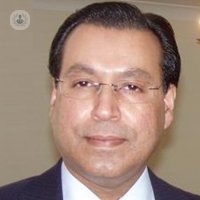The relationship between obstructive sleep apnoea and obesity
Written in association with:Obstructive sleep apnoea is a common condition that can cause a significant disturbance in the quality of our lives. It is predominantly a disease of obese and overweight people and with the rising obesity epidemic, the community prevalence of OSA is also rising.
Between 10-20% of all obese people have OSA and since 30% of the adult population in the UK is now obese (BMI >30) and another 28% is overweight, the prevalence of OSA is fairly high.
In this article, top consultant respiratory physician, Dr Muhammed Raashed explains the relationship between obstructive sleep apnoea and obesity, the health risks these conditions carry and the type of treatment that is available to help you have a better night’s sleep.

What is obstructive sleep apnoea (OSA)?
In OSA, the airways at the back of the throat collapse recurrently during sleep causing complete (apnoea) or partial cessation of airflow (hypopnoea) resulting in a repetitive drop in oxygen levels for the brain and other tissues. This leads to recurrent arousals through the night, sleep fragmentation and loss of restorative sleep. It causes people to wake up unrefreshed and feeling tired and sleepy during the day as if they haven’t slept the night before.
What are the dangers of being obese and having OSA?
A significant proportion (20%) of people who are obese develop a serious health condition called obesity hypoventilation syndrome (OHS). This group of people are at high risk of developing respiratory failure due to a combination of obesity and OSA and unlike simple OSA which carries no mortality, untreated OHS often decompensates and has a high mortality. OSA and OHS increase the risk for cardiovascular disease, hypertension and stroke. A lot of people are wrongly diagnosed with depression and chronic fatigue syndrome, and over 80% are on anti-depressants at diagnosis.
What are the symptoms?
People with OSA typically experience some of the following problems:
- Socially intrusive snoring
- Daytime sleepiness, tiredness or fatigue
- Occasionally people fall asleep driving
- Gasping or choking episodes during sleep
- Visits to the toilet in the night
- Feeling unrefreshed in the morning and having a morning headache
- Poor concentration and attention span leading to poor performance at work
- Loss of libido and erectile dysfunction
Anyone who has the above symptoms should seek for a home sleep study. People with sleep apnoea and excessive daytime sleepiness are advised by DVLA regulations from driving until their condition is fully treated.
How is OSA diagnosed?
OSA can be easily diagnosed by an overnight at-home sleep study. This is a service I have developed that allows you to carry out and manage your own sleep study, and the results can be posted back for downloading recorded data and diagnosis.
What treatment is available?
Once diagnosed, OSA can be easily treated with continuous positive airway pressure (CPAP). This is a simple device that blows air under pressure through your nose to maintain airway patency as you sleep. This restores sleep architecture, improves sleep quality and abolishes snoring and OSA. Most people report a life-changing experience within days of treatment, and in my 25 years of experience, this is the cheapest intervention that has the most dramatic benefit to my patients.
To make an appointment with Dr Muhammed Raashed, visit his Top Doctors profile and check his availability. He is also available through e-Consultation and instant messaging if you are unable to travel for a face-to-face appointment.


